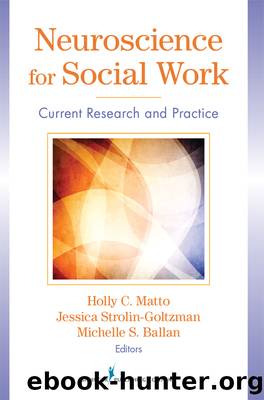Neuroscience for Social Work by Matto Holly;Strolin-Goltzman Jessica;Ballan Michelle;

Author:Matto, Holly;Strolin-Goltzman, Jessica;Ballan, Michelle;
Language: eng
Format: epub
Publisher: Springer Publishing Company, Incorporated
Universal screening measures should be used to rule out students who are not at risk for LD (Glover & Albers, 2007). Universal screening assessments should measure foundation skills upon which future learning depends, and on which poor performance predicts sustained functional impairments (e.g., illiteracy). Research has not supported teacher nomination as a reliable and valid source for the initial decision that a student is at risk for LD (Bahr & Fuchs, 1991; Marston, Mirkin, & Deno, 1984; Shinn, Tindal, & Spira, 1987). Diagnosticians can likely obtain universal screening data from the school and/or can make use of assessments (e.g., norm-and criterion-referenced assessments of foundation skills) to evaluate student risk for LD. Following universal screening, the subset of at-risk students should be exposed to a series of sensitive assessment procedures to rule out lack of motivation, inadequate instruction, and sensory impairments as causes of poor academic performance.
IDEA mandates that the evaluating agency must obtain parental consent to evaluate the child to determine if the child needs special education and related services, and must adhere to prescribed timeframes. The assessment must include a prereferral documented observation of the childâs or adolescentâs academic performance and behavior in his or her learning environment. The childâs or adolescentâs medical home professional should be included in this prereferral data gathering and that information included in the documentation. The physician or the medical home professional should also conduct a comprehensive assessment that begins with a physical examination (including neurological screening and mental status exams) and obtain the following medical and family histories.
Behavioral observation is an important tool as well. At the very least, the child should be observed at school in several different activities or classes and in the physicianâs or psychologistâs office. Ideally, home observations should also be scheduled. This data gathering should include three additional types of information: (a) the onset, frequency, duration, and intensity of problem issues or behaviors; (b) anecdotal information (parental and teacher observations); and (c) school records in addition to teacher observations.
IDEA mandates that a group of qualified professionals be convened to evaluate an individual who has met its mandates to receive a special education service evaluation. Assessment teams include the childâs parents, the child or the adolescent, and a group of qualified professionals. Multidisciplinary teams (comprised of educators, school psychologists and social workers, the involved parents, speech therapists, occupational therapists, and other specialists) are mandated by IDEA to evaluate eligibility for special education services or special accommodation in the school.
Download
This site does not store any files on its server. We only index and link to content provided by other sites. Please contact the content providers to delete copyright contents if any and email us, we'll remove relevant links or contents immediately.
Human Diseases (MindTap Course List) (by Team-IRA) by Marianne Neighbors Ruth Tannehill-Jones(768)
The Neglected Dimension of Global Security: A Framework to Counter Infectious Disease Crises by National Academy of Medicine Secretariat(399)
Statistical Methods in Health Disparity Research by J. Sunil Rao(383)
Imaging in Urology by Mitchell Tublin MD Joel B Nelson MD(372)
Short Course in Medical Terminology by Nath Judi L.;(312)
Clinical Research in Occupational Therapy, Sixth Edition by Martin Rice;(285)
Wilkins' Clinical Practice of the Dental Hygienist by Boyd Linda D.;Mallonee Lisa F.; & Lisa F. Mallonee(282)
Murray's Basic Medical Microbiology E-Book by Murray Patrick R.;(266)
Anatomical Kinesiology by Gross Michael;(262)
Psychedelics As Psychiatric Medications by Nutt David;Castle David;(256)
Neuroscience Fundamentals for Rehabilitation by Lundy-Ekman Laurie(254)
The Handbook of Medicinal Chemistry by Simon E Ward;Andrew Davis;(231)
Public Health and Society: Current Issues by Burke Lillian D.;Weill Barbara;(225)
Rang & Dale's Pharmacology 9th Edition plus Flashcards 2nd Edition by Unknown(224)
Cancer Cell Culture by Unknown(221)
Primary Care Occupational Therapy by Unknown(218)
Brown's Evidence-Based Nursing: the Research-Practice Connection by Nowak Emily W.;Colsch Renee; & Renee Colsch(217)
The Politics of Reproduction in Ottoman Society, 1838â1900 by Gülhan Balsoy(215)
From Good Schools to Great Schools by Susan P. Gray & William A. Streshly(214)
